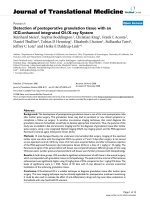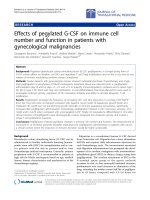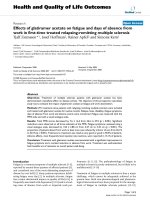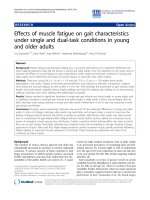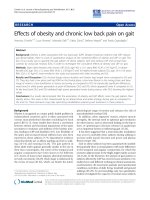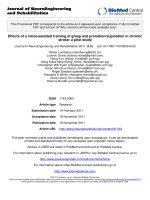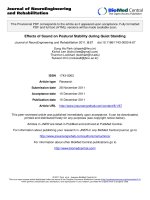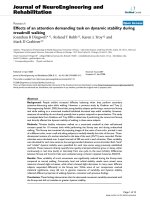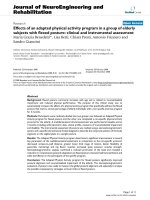báo cáo hóa học: " Effects of collagen membranes enriched with in vitro-differentiated N1E-115 cells on rat sciatic nerve " doc
Bạn đang xem bản rút gọn của tài liệu. Xem và tải ngay bản đầy đủ của tài liệu tại đây (628.01 KB, 13 trang )
RESEARC H Open Access
Effects of collagen membranes enriched with in
vitro-differentiated N1E-115 cells on rat sciatic
nerve regeneration after end-to-end repair
Sandra Amado
3†
, Jorge M Rodrigues
1,2†
, Ana L Luís
1,2†
, Paulo AS Armada-da-Silva
3
, Márcia Vieira
1
, Andrea Gartner
1
,
Maria J Simões
1
, António P Veloso
3
, Michele Fornaro
4
, Stefania Raimondo
4
, Artur SP Varejão
5
, Stefano Geuna
4*
,
Ana C Maurício
1,2*
Abstract
Peripheral nerves possess the capacity of self-regeneration after traumatic injury but the extent of regeneration is
often poor and may benefit from exogenous factors that enhance growth. The use of cellular systems is a rational
approach for delivering neurotrophic factors at the nerve lesion site, and in the present study we investigated the
effects of enwrapping the site of end-to-end rat sciatic nerve repair with an equine type III collagen membrane
enriched or not with N1E-115 pre-differentiated neural cells. After neurotmesis, the sciatic nerve was repaired by
end-to-end suture (End-to-End group), end-to-end suture enwrapped with an equine collagen type III membrane
(End-to-EndMemb group); and end-to-end suture enwrapped with an equine collagen type III membrane previously
covered with neural cells pre-differentiated in vitro from N1E-115 cells (End-to-EndMembCell group). Along the post-
operative, motor and sensory functional recovery was evaluated using extensor postural thrust (EPT), withdrawal
reflex latency (WRL) and ankle kinematics. After 20 weeks animals were sacr ificed and the repaired sciatic nerves
were processed for histological and stereological analysis. Results showed that enwrapment of the rapair site with
a collagen membrane, with or without neural cell enrichment, did not lead to any significant improvement in most
of functional and stereological predictors of nerve regeneration that we have assessed, with the exception of EPT
which recovered significantly better after neural cell enriched membrane employment. It can thus be concluded
that this particular type of nerve tissue engineering approach has very limited effects on nerve regeneration after
sciatic end-to-end nerve reconstruction in the rat.
Background
Nerve regeneration is a complex biological phenom-
enon. In the peripheral nervous system, nerves can
spontaneously regenerate without any trea tment if nerve
continuity is maintained (axonotmesis) whereas more
severe type of injuries must be surgically treated by
direct end-to-end surgical reconnection of the damaged
nerve ends [1-3]. Unfortunately, the functional outcomes
of nerve repair are in many cases unsatisfactory [4] thus
calling for research in order to reveal more effective
strategies for improving nerve regeneration. However,
recent advances in neuroscience, cell culture, genetic
techniques, and biomaterials provide optimism for new
treatments for nerve injuries [5-17].
The use of materials of natural origin has several
advantages in tissue engineer ing. Natural materials are
more likely to be biocompatible than artificial materials.
Also, they are less toxic and provide a good support to
cell adhesion and migration due to the presence of a
variety of surface molecules. Drawbacks of natural mate-
rials include potential difficulties in their isolation and
controlled scale-up [11]. In addition to the use of intact
natural tissues, a great deal of research has focused on
the use of purified natural extracellular matrix (ECM)
molecules, which can be modified to serve as appropri-
ate scaffolding [11]. ECM molecules, such as laminin,
fibronectin and collagen have also been shown to play a
* Correspondence: ;
† Contributed equally
1
Centro de Estudos de Ciência Animal (CECA), Instituto de Ciências e
Tecnologias Agrárias e Agro-Alimentares (ICETA), Universidade do Porto (UP),
Portugal
4
Department of Clinical and Biological Sciences, University of Turin, Italy
Amado et al. Journal of NeuroEngineering and Rehabilitation 2010, 7:7
/>JNER
JOURNAL OF NEUROENGINEERING
AND REHABILITATION
© 2010 Amado et al ; licensee BioMed Cen tral Ltd. This is an Open Access article distributed under the terms of the Creative Commons
Attribution License ( which permits unrestricted use, distribution, and reproduction in
any medium, provided the original work is properly cited.
sig nificant role in axonal development and regeneration
[12,18-27]. For example, silicone tubes filled with lami-
nin, fibronectin, and collagen led to a better regenera-
tion over a 10 mm rat sciatic nerve gap compared to
empty silicone controls [9]. Collagen filaments have also
been used to guide regenerating axons across 20-30 mm
defects in rats [23-27]. Further studies have shown that
oriented fibers of collagen within gels, aligned using
magnetic fields, provide an improved template for neur-
ite extension compared to randomly oriented collagen
fibers [28,29]. Finally, rates of regeneration comparable
to those using a nerve autograft have been achieved
using collagen tubes containing a porous collagen-glyco-
saminoglycan matrix [30-32]. Nerve regeneration
requires a complex interplay between cells, ECM, and
growth factors. The local presence of growth factors
plays an important role in controlling survival, migra-
tion, proliferation, and differentiation of the various cell
types involved in nerve regeneration [12-14,33]. There-
fore, therapies with relevant growth factors received
increasing attention in recent years although growth fac-
tor therapy is a difficult task because of the high biologi-
cal activity (in pico- to nanomolar range), pleiotrophic
effects (acting on a variety of targets), and short biologi-
cal half-life (few minutes to hours) [34]. Thus, growth
factors should be administered locally to achieve an ade-
quate therapeutic effect with little adverse reactions and
the short biological half-life of growth factors demands
for a delivery syste m that slowly releases locally the
molecules over a prolonged period of time. Employment
of biodegradable membranes enriched with a cellular
system producing neurotrophic factors has been sug-
gested to be a rational approach for improving nerve
regeneration after neurotmesis [11].
The aim of this study was thus to verify if rat sciatic
nerve regeneration after end-to-end reconstruction can be
improved by seeding in vitro differentiated N1E-115
neural cells on a type III equine coll agen membrane a nd
enwrap the membrane around t he le sion site. The N1E-
115 cell line has been established from a mouse neuroblas-
toma [35] and have already been used with conflicting
results as a cellular system to locally produce and deliver
neurotrophic fa ctors [12-14,36,37]. In vitro, the N1E-115
cells undergo neuronal differentiation in response to
dimethylsulfoxide (DMSO), adenosine 3’,5’-cyclic mono-
phosphate (cAMP), or serum withdrawal
[38-43,36,37,12-14]. Upon induction of differentiation,
proliferation of N1E-115 cells ceases, extensive neurite
outgrowth is observed and the membranes become highly
excitable [38-43,36,37,12-14]. The interval period of 48
hours of differentiation was previously determined by
measurement of the intracellular calcium concentration
([Ca
2+
] i). At this time point, the N1E-115 cells present
already the morphological characteristics of neuronal cells
but cell death due to increased [Ca
2+
] i is not yet occurring
as described elsewhere [38-43,36,37,12-14].
Methods
Cell culture
The N1E-115 cells, clones of cells derived from the
mouse neuroblastoma C-130035 retain numerous bio-
chemical, physiological, and morphological properties of
neuronal cells in culture [38-43,36,37,12-14]. N1E-115
neuronal cells were cultured in Petri dishes (around 2 ×
10
6
cells) over collagen type III membranes (Genta-
fleece®, Resorba Wundversorgung GmbH + Co. KG,
Baxter AG) at 37°C, 5% CO
2
in a humidified atmosphere
with 90% Dulbecco’ s Modified Eagle’s Medium (DMEM;
Gibco) supplemented with 10% fetal bovine serum (FBS,
Gibco), 100 U/ml penicillin, and 100 μg/ml streptomy-
cin (Gibco). The culture medium was changed every 48
hours and the Petri dishes were obse rved daily. The
cells were passed or were supplied with differentiating
medium containing 1.5% of DMSO once they reached
approximately 80% confluence, mostly 48 hours after
plating (and before the rats’ surgery). The differentiating
medium was composed of 96% DMEM supplemented
with 2.5% of FBS, 100 U/ml penicillin, 100 μg/ml strep-
tomycin and 1.5% of DMSO [12-14,36,37].
Surgical procedure
Adult male Sasco Sprague Dawley rats (Charles River
Laboratories, Barcelona, Spain) weighing 300-350 g,
were randomly divided in 3 groups of 6 or 7 animals
each. All animals were housed in a temperature and
humidity controlled room with 12-12 hours light/dark
cycles, two animals per cage (Makrolon type 4, Tecni-
plast, VA, Italy), and were allowed normal cage activities
under standard laboratory condi tions. The animals were
fed with standard chow and water ad libitum. Adequate
measures were taken to minimize pain and discomfort
taking in account human endpoints for animal suffering
and distress. Animals were housed for two weeks before
entering the experiment. For surgery, rats were placed
prone under sterile conditions and the skin from the
clipped lateral right thigh scrubbed in a routine fashion
with antiseptic solution. The surgeries were p erformed
under an M-650 operating microscope (Leica Microsys-
tems, Wetzlar, Germany). Under deep anaesthesia (keta-
mine 90 mg/Kg; xylazine 12.5 mg/Kg, atropine 0.25 mg/
Kg i.m.), the right sciatic nerve was exposed through a
skin incision extending from the greater trochanter to
themid-thighdistallyfollowedbyamusclesplitting
incision. After nerve mobilisation, a transection injury
was performed (neurotmesis) immediately above the
terminal nerve ram ification using str aight microsurgical
scissors. Rats were then randomly assigned to three
experimental groups. In one group (End-to-End),
Amado et al. Journal of NeuroEngineering and Rehabilitation 2010, 7:7
/>Page 2 of 13
immediate cooptation with 7/0 monofilament nylon epi-
neurial sutures of the 2 transected nerve endings was
performed, in a second group (End-to-EndMemb)nerve
transection was re constructed by end-to-end suture, like
in the first group, and then enveloped by a membrane
of equine collagen type III. In a third group (End-to-
EndMembCell) animals received the same treatment as
the previous group but with equine collagen type III
membranes covered with neural cells differentiated in
vitro. Sciatic nerves from the contralateral site were left
intact in all groups and served as cont rols. To prevent
autotomy, a deterrent substance was applied to rats’
right foot [44,45]. The animals were intensively exam-
ined for signs of autotomy and contracture during the
postoperative and none presented severe wounds, infec-
tions or contractures. All procedures were performed
with the approval of the Veterinary Authorities of Por-
tugal in accordance with the European Communities
Council Directive of November 1986 (86/609/EEC).
Evaluation of motor performance (EPT) and nociceptive
function (WRL)
Motor performance and nociceptive function were eval-
uated by measuring extensor postural thrust (EPT) and
withdrawal reflex latency (WRL), respectively. The ani-
mals were tested pre-operatively (week-0), at weeks 1, 2,
and every two weeks thereafter until week-20. The ani-
mals were gently handled, and tested in a quiet environ-
ment to minimize stress levels. The EPT was originally
proposed by Thalhammer and collaborators, in 1995
[46] as a part of the neurological recovery evalua tion in
the rat after sciatic nerve injury. For this test, the entire
body of the rat, excepting the hind-limbs, was wrapped
in a surgic al towel. Supporting the animal by the thorax
and lowering the affected hind-limb towards the plat-
form of a digital balance, elicits the EPT . As the animal
is lowered to the platform, it extends the hind-limb,
anticipating the contact made by the distal metatarsus
and digits. The force in grams (g) applied to the digital
platform balance (model TM 560; Gibertini, Milan,
Ital y) was recorded. The same procedure was applied to
the contralateral, unaffected limb. Each EPT test was
repeated 3 times and the average result was considered.
The normal (unaffected limb) EP T (NEPT) and experi-
mental EPT (EEPT) values were incorporated into an
equation (Equation 1) to derive the functional deficit
(varying between 0 and 1), as described by Koka and
Hadlock, in 2001 [47].
Motor Deficit NEPT EEPT NEPT()/
(1)
To assess the nociceptive withdrawal reflex (WRL),
the hotplate test was modified as described by Masters
and collaborators [48]. The rat was wrapped in a
surgical towel above its waist and then positioned to
stand with the affected hind paw on a hot plate at 56°C
(mo del 35-D, IITC Life Science Instruments, Woodland
Hill, CA). WRL is defined as the time elapsed from the
onset of hotplate contact to withdrawal of the hind paw
and measured with a stopwatch. Normal rats withdraw
their paws from the hotplate within 4.3 s or less [49].
The affected limbs were tested 3 times, with an interval
of 2 min between consecut ive tests to prevent sensitiza-
tion, and the three latencies were averaged to obtain a
final result [50,51]. If there was no paw withdrawal after
12 s, the heat stimulus was removed to prevent tissue
damage, and the animal was assigned the maximal WRL
of 12 s [52].
Kinematic Analysis
Ankle kinematics during the stance phase of the rat
walk was recorded prior nerve injury (week-0), at week-
2 and every 4 weeks during the 20-week follow-up time.
Animals walked on a Perspex track with length, width
and height of respectively 120, 12, and 15 cm. In order
to ensure locomotion in a straight direction, the width
of the apparatus was adjusted to the size of the rats
during the experiments, and a darkened cage was placed
at the end of the corridor to attract the animals. The
rats gait was video recorded at a rate of 100 images per
second (JVC GR-DVL9800, New Jersey, USA). The
camera was positioned perpendicular to the mid-point
of the corridor length at a 1-m distance thus obtaining
a visualization field of 14-cm wide. Only walking trials
with stance phases l asting between 150 and 400 ms
were considered for analysis, since this corresponds to
the normal walking velocity of the rat (20-60 cm/s)
[52-54]. The video images were stored in a comput er
hard disk for latter analysis using an appropriate soft-
ware APAS® (Ariel Performance Analysis System, Ariel
Dynamics, San Diego, USA). 2-D biomechanical analysis
(sagittal plan) was carried out applying a two-segment
model of the ankle joint, adopted from the model firstly
developed by Varejão and collaborators [52-55]. Skin
landmarks were tattooe d at points in the proximal edge
of the tibia, in the lateral malleolus and, in the fifth
metatarsal head. The rats’ ankle angle was determined
using the scalar product between a vector representing
the foot and a vector representing the lower leg. With
this model, positive and negat ive values of position of
the ankle joint indicate dorsiflexion and plantarflexion,
respectively. For each stance phase the following time
points were identified: initial contact (IC), opposite toe-
off (OT), heel-rise (HR) and toe-off (TO) [52-55], and
were time normalized for 100% of the stance phase.
The normalized temporal parameters were averaged
over all recorded trials. Angular velocity of the ankle
joint was also determined where negative values
Amado et al. Journal of NeuroEngineering and Rehabilitation 2010, 7:7
/>Page 3 of 13
correspond to dorsiflexion. Four steps were analysed for
each animal [55].
Histological and Stereological analysis
A 10-mm-long segment of the sciatic nerve distal to the
site of lesion was removed, fixed, and prepared for
quantitative morphometry of myelinated nerve fibers. A
10-mm segment of uninjured sciatic nerve was also
withdrawn from control animals (N = 6). The harvested
nerve segments were immersed immediately in a fixa-
tion solution containing 2.5% purified glutaraldehyde
and 0.5% saccarose in 0.1 M Sorensen phos phate buffer
for 6-8 hours. Specimens were processed for resin
embedding as described in details elsewhere [56,57]. Ser-
ies of 2-μm thick semi-thin transver se sections were cut
using a Leica Ultracut UCT ultramicrotome (Leica
Micro systems, Wetzlar, Germany) and stained by Tolui-
dine blue for stereological analysis of regenerated nerve
fibers. The slides were observed with a DM4000B
microscope equipped with a DF C320 digital camera and
an IM50 image manager system (Leica Microsystems,
Wetzlar, Germany). One semi-thin section from each
nerve was randomly selected and used for the morpho-
quantitative analysis. The total cross-sectional area of
the nerve was measured and sampling fields were then
randomly selected using a protocol previously described
[57-59]. Bias arising from the “edge effect” was coped
with the employment of a two-dimensional disector pro-
cedure which is based on sampling the “tops” of fibers
[60,61]. Mean fiber density in each disector was then
calculated by dividing the number of nerve fibers
counted by the disector’sarea(N/mm
2
). Finally, total
fiber number (N) in the nerve was estimated by multi-
plying the mean fiber density by the total cross-sectional
area of the whole nerve. Two-dimensional disector
probes were also used for the unbiased selection of a
representative sample of myelinated nerve fibers for esti-
mating circle-fitting diameter and myelin thickness. Pre-
cision and accuracy of the estimates were evaluated by
calculating the coefficient of variation (CV = SD/mean)
and coefficient of error (CE = SEM/mean) [57-59].
Statistical analysis
Two-way mixed factorial ANOVA was used to test for
the effect of time in the End-to-End group (within sub-
jects effect; 12 time points) and experimental groups
(between subjects effect, 3 groups). The sphericity
assumption was evaluated by the Mauchly’stestand
when this test could not be computed or when spheri-
city assumption was violated, adjustment of the degrees
of freedom was done with the Greenhouse-Geiser’s epsi-
lon. When time main effect was significant (wit hin sub-
jects factor), simple planned contrasts (General Linear
Model, simple contrasts) were used to compare pooled
data across the three experimental groups along the
recovery with data at week-0. When a significant main
effect of treatment existed (between subjects factor),
pairwise com parisions were carried out using the
Tukey’ s HSD test. At we ek-0, kinematic data was
recorded only from the End-to-End group so the main
effect of time was evaluated only in this group. Evalua-
tion of the main effect of treatment on ankle motion
variables used only data after nerve injury. In this case,
and when appro priate, pairwise comparisons were made
using the Tukey’s HSD test. Statistical comparisons of
stereological morpho-quantitative data on nerve fibers
were accomplished with one-way ANOVA test. Statisti-
cal significance was established as p < 0.05. All statistical
procedures were performed by using the statistical pack-
age SPSS (version 14.0, SPSS, Inc) except stereological
data that were analysed using the software “ Stat istica
per discipline bio-mediche“ (McGraw-Hill, Milan, Italy).
All data in this study is presented as mean ± standard
error of the mean (SEM).
Results
Motor deficit and Nociception function
Motor deficit (EPT)
Before sciatic injury, EPT was similar in both hindlimbs
in all experimental groups (figure 1). In the first week
after sciatic nerve transection, near total EPT loss was
observed in the operated hindlimb, leading to a motor
deficit ranging between 83 to 90%. The EPT response
steadily improved during recovery but at week-20 the
EPT values of the injured side were still significantly
lower compared to values at week-0 (p < 0.05). A signif-
icant main effect for treatment w as found [F
(2,17)
=
14.202; p = 0.000], with pairwise comparisons showing
significantly better recovery of the EPT response in the
End-to-EndMembCell groupwhencomparedtothe
other two experimental groups (p < 0.05). At week-20,
motor deficit decreased to 27% in the End-to-EndMemb-
Cell and to 34% and 42% in the End-to-End and End-to-
EndMemb groups, respectively (figure 1).
Nociception function (WRL)
In the week after sciatic transaction, all the animals pre-
sented a severe loss of sensory and nociception function
acutely after sciatic nerve transection a nd the WRL test
has to be interrupted at the 12 s-cutoff time (figure 2).
During the following weeks there was recovery in paw
nociceptio n which was more clearly seen between weeks
6 and 8 post-surgery. At week-6, half of the animals still
had no withdrawal response to the noxious thermal sti-
mulus in the operated side, which is in contrast with
week-8, when all animals presented a consistent,
although delayed, response. Despite such improvement
in WRL r esponse, contrast analysis showed persistence
of sensory deficit in all groups by the end of the 20-
Amado et al. Journal of NeuroEngineering and Rehabilitation 2010, 7:7
/>Page 4 of 13
weeks recovery time (p < 0.05). No differences between
the groups was observed in the level of WRL impair-
ment after the sciatic nerve transection [F
(2,17)
=1.563;
p = 0.238].
Kinematics Analysis
Figures 3 and 4 display the mean plots, respectively for
ankle joint angle and ankle joint velocity during the
stance phase of the rat walk. Comparisons to the normal
ankle motion can only be draw for the End-to-End
group for reasons explained in the Methods section. In
the weeks following sciatic nerve transection, ankle joint
motion became severely abnormal, particularly through-
out the second half of stance corresponding to the
push-off sub-phase. In clear contrast to the normal pat-
tern of ankle movement, at week-2 post-injury animals
were unable to extend this joint and dorsiflexion contin-
ued increasing during the entire stance, which is
explained by the paralysis of plantarflexor muscles. The
pattern of the ankle joint m otion seemed to have
improved only slightly during recovery. Contrast analysis
was performed for each of the kinematic parameters
(tables 1 and 2) with somewhat different results. For OT
velocity and HR angle no differ ences existed before and
after sciatic nerve transection, whereas for OT angle dif-
ferences from pre-injury values were significant only at
weeks 2 and 16 of recovery (p < 0.05). The angle at IC
showed a unique pattern of changes, being unaffected at
week-2 post-injury and altered from normal in the fol-
lowing weeks of recovery. Probably the most consistent
results are those of HR velocity, TO angle and TO velo-
city. These parameters were affected immediately after
the nerve injury and remained abnormal along the
entire 20-weeks recovery period (p < 0.05). The effect of
the different tissue engineering strategies was assessed
comparing the kinematic data of the experimental
groups only during the recovery period (see Methods).
Statistical analysis demonstrated that the collagen mem-
brane and the cells had no or little effect on ankle
motion pattern recovery. Generally, no differences in
the kinematic parameters were found between the
groups. Exceptions were IC velocity in the End-to-End-
MembCell gro up, which was di fferen t from the other
two groups (p < 0.05), and OT angle in the End-to-End-
Memb group that was also different from the other two
groups (p < 0.05).
Histological and Stereological Analysis
Figure 5 shows representative light micrographs of the
regenerated sciatic nerves of the three groups (figure
5A-C) and contro l sciatic normal nerves (figure 5D). As
expected, regeneration of axons was organized in many
smaller fascicles in comparison to controls. The results
of the stereological analysis of myelinated nerve fibers
are reported in Table 3. Statistical analysis by ANOVA
test revealed no significant (p > 0.05) difference
Figure 1 Weekly values of the percentage of motor deficit obtained by the Extensor Postural Thrust (EPT) test. * Significantly different
from week-0 all groups pooled together (p < 0.05). # Group End-to-EndMembCell significantly different from the other groups (p < 0.05). Results
are presented as mean and standard error of the mean (SEM).
Amado et al. Journal of NeuroEngineering and Rehabilitation 2010, 7:7
/>Page 5 of 13
regarding any of the morphological parameters investi-
gated in the regenerated axons from the three experi-
mental groups. On the other hand, comparison between
regenerated and control nerves showed, as expected, the
presence of a signi ficantly (p < 0.05) higher density and
total number of myelinated axons in experimental
groups accompanied by a significantly (p < 0.05) lower
fiber diameter.
Discussion
Transected peripheral nerves can regenerate provided
that a connection is available between the proximal and
distal severed stumps and, when no substance loss
occurred, surgical treatment consists in direct end-to-
end suturing of the nerve ends [1-3,62,63]. However, i n
spite of the progress of microsurgical nerve repair, the
outcome of nerve reconstruction is still far from being
optimal
4
. Since during regeneration axons require neu-
rotrophic support, they could benefit from the presence
of a growth factors delivery cell system capable of
responding to stimuli of the local environment during
axonal regeneration.
In the present study, we aimed at investigating the
effects of enwrapping the site of end-to-end rat sciatic
nerve repair with equine type III collagen nerve mem-
branes either alone or enriched with N1E-115 pre-differ-
entiated into neural cells in the presence of 1.5% of
DMSO . The rationale for the utilization of the N1E-115
cells was to take advantages of the properties of these
cells as a neural-li ke cellular source of neurotrophic fac-
tors [12-14,36,37].
Results showed that enwrapment with a collagen
membrane, with or without neural cell enrichment, did
not lead to any significant improvement in most of
functional and stereological predictors of nerve regen-
eration that we have assessed. The only exception was
represented by motor deficit recovery which was signifi-
cantly improved after lesion site enwrapment with mem-
brane enriched with neural cells pre-differentiated from
N1E-115 cell line.
Natural tissues possess several advantages when com-
pared to synthetic materials, when use to reconstruct
peripheral nerves after injury. Natural materials are
more likely to be bioco mpatible than artificial materials,
arelesstoxic,andprovideasupportstructuretopro-
mote cell adhesion and migration. Drawbacks, on the
other hand, include potential difficulties with isolation
and controlled scale-up. In addition to intact acellular
tissues, a great deal of research has focused on the use
of purified natural ECM proteins and glycosaminogly-
cans, which can be modified to serve as appropriate
scaffolding. ECM molecules, such as laminin, collagen,
and fibronectin, have been shown to play a significant
role in axonal development and repair in the body
Figure 2 Weekly values of the withdrawal reflex latency test. At week-1 all animals failed in responding to the noxious thermal stimulus
within the 12 sec cut-off time. No differences between the percentages of motor deficit obtained by the Extensor Postural Thrust (EPT) test. *
Significantly different from week-0 all groups pooled together (p < 0.05). Results are presented as mean and standard error of the mean (SEM).
Amado et al. Journal of NeuroEngineering and Rehabilitation 2010, 7:7
/>Page 6 of 13
2 w eeks post-injury
-60.00
-40.00
-20.00
0.00
20.00
40.00
60.00
80.00
050100
Stance phase duration (%)
Angular
position (º)
Control End-t o-End
End-t o-EndMemb End-t o-EndMembCell
4 w eeks post-injury
-60.00
-40.00
-20.00
0.00
20.00
40.00
60.00
80.00
0 50 100
Stance phase duration (%)
Angular
position (º)
Cont rol End-t o-End
End-t o-EndMemb End- t o-EndMembCell
8 w eeks post-injury
-60.00
-40.00
-20.00
0.00
20.00
40.00
60.00
80.00
0 50 100
Stance phase duration (º)
Angular
position (º)
Cont rol End-t o-End
End-t o-EndMemb End- t o-EndMembCell
12 weeks post-injury
-60.00
-40.00
-20.00
0.00
20.00
40.00
60.00
80.00
0 20406080100
Stance phase duration (%)
Angular
position (º)
Control End-to-End
End-to-EndMemb End-to-EndMembCell
16 w eeks post-injury
-60.00
-40.00
-20.00
0.00
20.00
40.00
60.00
80.00
0 50 100
Stance phase duration (%)
Angular
position (º)
Cont rol End- t o-End
End-t oEndMemb End-t o-EndMembCell
20 weeks post-injury
-60.00
-40.00
-20.00
0.00
20.00
40.00
60.00
80.00
050100
Stance phase duration (%)
Angular
position (º)
Control End-to-End
End-to-EndMemb End-to-EndMembCell
Figure 3 Kinematics plots in the sagittal plane for the angular position (°) of the ankle as it moves through the stance phase, during
the healing period of 20 weeks. The mean of each group is plotted.
Amado et al. Journal of NeuroEngineering and Rehabilitation 2010, 7:7
/>Page 7 of 13
2 w eeks post-injury
-1000.00
-500.00
0.00
500.00
1000.00
0 50 100
Syance phase duration (%)
Angular
velocity
(º/s)
Control End-to-End
End-to-EndMemb End-to-EndMembCell
4 w eeks post-injury
-1000.00
-500.00
0.00
500.00
1000.00
050100
Stance phase duration (%)
Angular
velocity
(º/s)
Control End - t o - En d
End - t o - En d Memb End-to-EndMembCell
8 w eeks post-injury
-1000.00
-500.00
0.00
500.00
1000.00
0 50 100
Stance phase duration (%)
Angular
velocity
(º/s)
Control End-to-End
End-to-EndMemb End-to-EndMembCell
12 w eeks post-injury
-1000.00
-500.00
0.00
500.00
1000.00
0 50 100
Stance phase duration (%)
Angular
velocity
(º/s)
Control End-to-End
End-to-EndMemb End-to-EndMembCell
16 w eeks post-injury
-1000.00
-500.00
0.00
500.00
1000.00
0 50 100
Stance phase duration (%)
Angular
velocity
(º/s)
Control End - t o - En d
End-to-EndMemb End-to-EndMembCell
20 weeks post-injury
-1000.00
-500.00
0.00
500.00
1000.00
0 50 100
Stance phase duration (%)
Angular
velocity (º/s)
Control End-to-End
End-to-EndMemb End-to-EndMembCell
Figure 4 Kinematics plots in the sagittal plane for the angular velocity (°/s) of the ankle as it moves through the stance phase, during
the healing period of 20 weeks. The mean of each group is plotted.
Amado et al. Journal of NeuroEngineering and Rehabilitation 2010, 7:7
/>Page 8 of 13
Table 1 Ankle kinematics and stance duration analysis were carried out prior to nerve injury (week-0), at week-2, and
every 4 weeks during the 20-week follow-up period.
Temporal
Parameter
Week 0 Week 2 Week 4 Week 8 Week 12 Week 16 Week 20
IC End-to-End -4.84 ± 3.00 2.70 ± 1.29 -30.11 ± 5.38 -20.88 ± 4.22 -28.36 ± 3.84 -38.92 ± 4.82 -52.83 ± 6.46
End-to-EndMemb 7.19 ± 2.94 -6.25 ± -2.55 -19.65 ±
-8.02
-48.15 ±
-19.66
-46.87 ±
-19.13
-39.03 ±
-15.93
End-to-
EndMembCell
4.95 ± 0.68 -31.59 ±
12.98
-23.79 ± 2.47 -29.57 ± 5.74 -42.25 ± 11.38 -46.04 ± 9.29
OT End-to-End 25.65 ± 1.08 36.74 ±
4.71
18.75 ± 2.81 25.58 ± 8.88 24.79 ± 2.62 4.71 ± 4.35 16.61 ± 3.96
End-to-EndMemb 20.37 ±
4.61
21.54 ± 9.92 9.78 ± 18.75 4.26 ± 18.44 -19.51 ± 16.74 -18.70 ± 20.74
End-to-
EndMembCell
33.15 ±
2.98
25.08 ± 4.86 28.15 ± 8.57 24.54 ± 8.91 21.75 ± 5.76 16.47 ± 6.73
HR End-to-End 30.67 ± 2.44 51.20 ±
4.50
40.03 ± 2.21 36.82 ± 5.96 34.01 ± 5.87 34.30 ± 3.35 40.37 ± 4.75
End-to-EndMemb 52.46 ±
2.16
48.04 ± 5.49 29.65 ±
22.49
20.89 ± 21.10 11.57 ± 20.18 4.16 ± 26.71
End-to-
EndMembCell
54.80 ±
2.44
44.16 ± 3.90 46.41 ± 6.68 43.69 ± 6.09 41.53 ± 6.66 29.08 ± 7.55
TO End-to-End -12.27 ±
7.01
41.49 ±
3.23
39.33 ± 3.03 27.28 ± 1.38 28.04 ± 3.11 15.02 ± 3.78 12.16 ± 3.43
End-to-EndMemb 35.56 ±
1.69
50.77 ± 4.41 34.64 ±
21.86
16.36 ± 20.87 2.12 ± 18.58 4.60 ± 25.45
End-to-
EndMembCell
48.10 ±
1.60
44.76 ± 4.17 36.40 ± 6.11 23.37 ± 4.02 18.64 ± 5.76 8.71 ± 4.20
Values of the ankle angular position (°) at initial contact (IC); opposite toe-off (OT); heel-rise (HR); toe-off (TO) of the stance phase. Results are presented as mean
and standard error of the mean (SEM). N corresponds to the number of rats within the experimental group.
Table 2 Ankle kinematics and stance duration analysis were carried out prior to nerve injury (wek-0), at week-2, and
every 4 weeks during the 20-week follow-up period.
Temporal
Parameter
Week 0 Week 2 Week 4 Week 8 Week 12 Week 16 Week 20
IC End-to-End -194.15 ±
44.35
-448.33 ±
66.25
-604.86 ±
66.95
-351.64 ±
73.81
-639.43 ±
120.70
-809.90 ±
88.67
-647.63 ±
81.94
End-to-EndMemb -728.48 ±
-297.40
-785.62 ±
-320.73
-593.43 ±
-242.26
-234.56 ±
-95.76
-302.06 ±
-123.31
-514.54 ±
-210.06
End-to-
EndMembCell
-557.10 ±
224.85
-505.97 ±
108.58
-845.50 ±
160.47
-933.63 ±
57.41
-914.05 ±
80.10
-903.24 ±
74.55
OT End-to-End -270.35 ±
19.65
-273.97 ±
47.92
-385.24 ±
37.99
-399.28 ±
34.85
-530.42 ±
68.29
-460.90 ±
66.08
-414.22 ±
35.18
End-to-EndMemb -641.95 ±
-262.08
-528.60 ±
-215.80
-321.92 ±
-131.42
-449.49 ±
-183.50
-582.66 ±
-237.87
-411.32 ±
-167.92
End-to-
EndMembCell
-357.80 ±
43.21
-495.68 ±
82.13
-372.17 ±
33.65
-467.31 ±
76.14
-471.29 ±
20.94
-278.67 ±
20.71
HR End-to-End 53.25 ±
40.58
-177.64 ±
41.45
-246.61 ±
11.49
-333.55 ±
16.41
-280.20 ±
24.32
-322.47 ±
18.46
-322.86 ±
23.80
End-to-EndMemb -265.19 ±
28.15
-301.10 ±
65.99
-268.48 ±
64.92
-114.06 ±
82.52
-327.76 ±
86.17
-222.91 ±
51.33
End-to-
EndMembCell
-353.02 ±
24.39
-285.60 ±
21.13
-190.41 ± 9.69 -286.61 ±
57.54
-283.54 ±
12.24
-216.29 ±
21.36
TO End-to-End -221.38 ±
91.28
322.87 ±
109.64
327.44 ±
31.23
399.79 ±
82.70
403.59 ±
57.88
444.05 ±
78.95
193.03 ±
130.15
End-to-EndMemb 554.31 ±
69.27
384.52 ±
66.65
227.17 ±
123.13
281.98 ±
79.91
577.14 ±
155.51
311.14 ±
197.88
End-to-
EndMembCell
248.78 ±
30.40
420.52 ±
28.58
355.25 ±
43.90
466.17 ±
43.54
551.88 ±
43.74
460.01 ±
51.01
Values of the ankle angular velocity (°/sec) at initial contact (IC); opposi te toe-off (OT); heel-rise (HR); toe-off (TO) of the stance phase. Results are presented as
mean and standard error of the mean (SEM). N corresponds to the number of rats within the experimental group.
Amado et al. Journal of NeuroEngineering and Rehabilitation 2010, 7:7
/>Page 9 of 13
[19,24]. There are a number of examples in which the
ECM proteins laminin, fibronectin, and collagen have
been used for nerve repair applications [12,18-27]. For
example, silicone tubes filled with laminin, fibronectin,
and collagen show improved regeneration over a 10 mm
rat sciatic nerve gap compared to empty silicone con-
trols [9]. Collagen filaments have also been used to
guide regenerating axons across 20-30 mm defects in
rats [23,26,27]. Further studies have shown that oriented
fibers of collagen within gels, aligned using magnetic
fields, provide an improved template for neurite exten-
sion compared to randomly oriented collagen fibers
[28,29]. Rates of regeneration after neurotmesis
comparable to those using a nerve autograft have been
achieved using collagen tubes containing a porous col-
lagen-glycosaminoglycan matrix [31,32].
Results of this study contribute to the lively debate
about the employment of cell transplantation for
improving post-traumatic nerve regeneration [64,65].
Actually, a great enthusiasm among researchers and
especially the public opinion has risen over the last
years about cell-based therapies in Regenerative Medi-
cine [66-68] and there seems to be widespread convic-
tion that this type of therapy is not only effective but
also very safe in comparison to other pharmacological
or surgical therapeutic approaches. By contrast, recent
studies showed that cell-based therapy might be ineffec-
tive for improving nerve regeneration [66-69], and
results of the present study are in line with these obser-
vations. Recently, it has even been shown that N1E-115
cell transplantation can also have negative results by
hindering the nerve regeneration process after tubu lisa-
tion repair [12]. Of course, the choice of the cell type to
be used for trans plantation is very imp ortant for the
therapeutic success and use of another cell type could
have led to better results, especially when the cellular
system of choice is derived from autologous or heterolo-
gous stem cells1 [1,12,15-17,64,70]. Moreover, the con-
struction of more appropriate tube-guides with
Table 3 Stereological quantitative assessment density,
total number, diameter and myelin thickness of
regenerated sciatic nerve fibers at week-20 after
neurotmesis.
N/mm
2
Density
N
Number
D
Fiber diameter
(μm)
EndtoEnd 20,612 ± 1,607 14,624 ± 1,642 4.06 ± 0.30
EndtoEndMemb 23,575 ± 1,018 15,101 ± 1,172 3.87 ± 0.18
EndtoEndMembCell 22,394 ± 1,750 14,467 ± 1,524 3.96 ± 0.21
Control 15,905 ± 287 7,666 ± 190 6.66 ± 0.12
Values are presented as mean ± SEM.
Figure 5 Representative high resolution photomicrographs of nerve fibers form regenerated (A-C) and normal (D) rat sciatic nerves.A:
End-to-End.B:End-to-EndMemb.C:End-to-EndMembCell. Magnification = × 1,500.
Amado et al. Journal of NeuroEngineering and Rehabilitation 2010, 7:7
/>Page 10 of 13
integrated growth factor delivery systems and/or cellular
components could improve the effectiveness of nerve
tissue engineering. In fact, single-molded tube guides
may not give sufficient control over both the mechanical
properties and the delivery of bioactive agents. More
complex devices will be needed, such as multilayered
tube guides where growth factors are entrapped in poly-
mer layers with varying physicochemical properties or
tissue engineered tube guides containing viable stem
cells [1,12,15-17,64,70]. The combination of two or
more growth factors will likely exert a synergistic effect
on nerve regeneration, especially when the growth fac-
tors belong to different families and act via different
mechanisms. Combinations of growth factors can be
expected to enhance further nerve regeneration, particu-
larly when each of them is delivered at individually tai-
lored kinetics [11,12,15-17,64,70,71]. The dete rmination
and control of suitable delivery kinetics for each of sev-
eral growth factors will constitute a major hurdle both
technically and biologically with the biological hurdle
lying in the compliance with the naturally occurring
cross talk between growth factors and cells. A solution
to this problem may be the use of autologous stem cells
because they can synthesize several growth factors and
differentiate into Schwann cells which are critical for
very long gaps [11,12,15-17,64,70,71].
Previous work already published by other research
groups, point out a very interesting source of stem cell s
for nerve regeneration of peripheral nerve a nd spinal
cord. They developed hair follicle pluripotent stem cells
(hfPS) and have shown that these cells can differentiate
to neurons, glial cells in vitro, and other cell types, and
can promote nerve and spinal cord regeneration in vivo.
These cells are located above the hair follicle bulge
(hfPS cell area) and are nestin and CD34 positive, and
keratin 15 negative [72-75]. The mouse hfPS cells were
impl anted into the gap region of the severed sciatic and
tibial nerve o f mice. These cells, after 6-8 weeks, trans-
differentiated largely into Schwann cells. Also, blood
vessels formed a network around the joined sciatic and
tibial nerve. Function of the rejoined sciatic and tibial
nerve was confirmed by contraction of the gastrocne-
mius muscle upon electrical stimulation and by walking
track analysis [73-75]. hfPS cells can promote axonal
growth and functional recovery after peripheral nerve
injury, offering an important opportunity for future clin-
ical application. These hfPS cells, in contrast to Embrio-
nic stem cells, N1E-115 cells after in vitro differentiation
and induced pluripotent stem cells, do not require any
genetic manipulation, are readily accessible from any
patient, and lack the ethical issues, do not form tumors.
Acknowledgements
The authors would like to gratefully acknowledge the valuable support by
Dr. José Manuel Correia Costa, from Laboratório de Parasitologia, Instituto
Nacional de Saúde Dr. Ricardo Jorge (INSRJ), Porto, Portugal. This work was
supported by and by Fundação para a Ciência e Tecnologia (FCT) from
Ministério da Ciência e Ensino Superior (MCES), Portugal, through the
financed research project PTDC/CVT/64220/2006, and by the Regione
Piemonte (Progetto Ricerca Sanitaria Finalizzata). Stefania Raimondo is
recipient of a PostDoc grant partially supported by the Regione Piemonte
(Azione Contenimento del Brain Drain).
Author details
1
Centro de Estudos de Ciência Animal (CECA), Instituto de Ciências e
Tecnologias Agrárias e Agro-Alimentares (ICETA), Universidade do Porto (UP),
Portugal.
2
Departamento de Clínicas Veterinárias, Instituto de Ciências
Biomédicas Abel Salazar (ICBAS), Universidade do Porto (UP), Portugal.
3
Faculdade de Motricidade Humana (FMH), Universidade Técnica de Lisboa
(UTL), Portugal.
4
Department of Clinical and Biological Sciences, University of
Turin, Italy.
5
Departamento de Ciências Veterinárias, Universidade de Trás-os-
Montes e Alto Douro (UTAD), Portugal.
Authors’ contributions
SA, APV and ASPV carried out the kinematic collecting data and the
kinematic data analysis, participated in the functional data analysis, JMR and
ALL carried out the animal surgeries, euthanasia, preparation of samples for
histological and stereological analysis and participated in the functional
evaluation analysis, PASADS carried out all the statistical analysis, the
interpretation of kinematic data and participated in the paper draft, MV,
AGand MJS performed the functional evaluation and analysis and were
responsible for keeping the experimental animals, MF, SR, and SG performed
the histological and stereological analysis, ACM carried out the animal
surgeries euthanasia and preparation of samples for histological and
stereological analysis. ACM together with SG and PASADS designed and
coordinated the study, elaborated the manuscript and were responsible for
the funding acquisition. All the authors read and approved the final
manuscript.
Competing interests
The authors declare that they have no competing interests.
Received: 4 September 2009
Accepted: 11 February 2010 Published: 11 February 2010
References
1. Lundborg G: Bridging nerve defects: the role of tissue interpositioning.
Severe Traumatic Defects of the Upper Limb London: Martin DunitzMasquelet
AC, Ferreira AC 2003, 153-167.
2. Matsuyama T, Mackay M, Midha R: Peripheral nerve repair and grafting
techniques: a review. Neurol Med Chir 2000, 40:187-199.
3. Siemionow M, Brzezicki G: Current techniques and concepts in peripheral
nerve repair. Int Rev Neurobiol 2009, 87:139-170.
4. Gordon T, Sulaiman OA, Ladak A: Electrical Stimulation for Improving
Nerve Regeneration: Where do we stand?. Int Rev Neurobiol 2009,
87:433-444.
5. Doolabh VB, Hertl MC, Mackinnon SE: The Role of Conduits in Nerve
Repair, a Review. Rev Neurosci 1996, 7:47-84.
6. Jensen JN, Tung TH, Mackinnon SE, Brenner MJ, Hunter DA: Use of anti-
CD40 ligand Monoclonal Antibody as Antirejection Therapy in a Murine
Peripheral Nerve Allograft Model. Microsurgery 2004, 24:309-315.
7. Lundborg G: Alternatives to Autologous Nerve Grafts. Handchir, Mikrochir,
Plast Chir 2004, 36:1-7.
8. Geuna S, Papalia I, Tos P: End-to-side (Terminolateral) Nerve
Regeneration: a Challenge for Neuroscientists Coming from an
Intriguing Nerve Repair Concept. Brain Res Rev 2006, 52:381-388.
9. Chen YS, Hsieh CL, Tsai CC, Chen TH, Cheng WC, Hu CL, Yao CH: Peripheral
nerve regeneration using silicone rubber chambers filled with collagen,
laminin and fibronectin. Biomaterials 2000, 21:1541-1547.
10. Den Dunnen WFA, Van Wessel R, Pennings AJ, Robinson PH, Van
Leeuwen MBM, Schakenraad JM: Long-term evaluation of degradation
and foreign body reaction of subcutaneously implanted poly (DL-
lactide-ε-caprolactone). J Biomed Mater Sci 1997, 36:337-346.
Amado et al. Journal of NeuroEngineering and Rehabilitation 2010, 7:7
/>Page 11 of 13
11. Schmidt CE, Leach JB: Neural Tissue Engineering: Strategies for repair
and regeneration. Annu Rev Biomed Eng 2003, 5:293-347.
12. Luís AL, Rodrigues JM, Geuna S, Amado S, Shirosaki Y, Lee JM, Fregnan F,
Lopes MA, Veloso AP, Ferreira AJ, Santos JD, Armada-da-Silva PAS,
Varejão ASP, Maurício AC: Use of PLGA 90:10 scafolds enriched with in
vitro-differentiated neural cells for repairing rat sciatic nerve defects.
Tissue Engineering Part A 2008, 14(6):979-993.
13. Luís AL, Rodrigues JM, Geuna S, Amado S, Simões MJ, Fregnan F,
Ferreira AJ, Veloso AP, Armada-da-Silva PAS, Varejão ASP, Maurício AC:
Neural cell transplantation effects on sciatic nerve regeneration after
standardized crush injury in the rat. Microsurgery 2008, 28(6):458-470.
14. Amado S, Simões MJ, Armada-da-Silva PAS, Luís AL, Shirosaki Y, Lopes MA,
Santos JD, Fregnan F, Gambarotta G, Raimondo S, Fornaro M, Veloso AP,
Varejão ASP, Maurício AC, Geuna S: Use of hybrid chitosan membranes
and N1E-115 cells for promoting nerve regeneration in an axonotmesis
rat model. Biomaterials 2008, 29(33):4409-4419.
15. Battiston B, Raimondo S, Tos P, Gaidano V, Audisio C, Scevola A, Perroteau I,
Geuna S: Tissue engineering of peripheral nerves. Int Rev Neurobiol 2009,
87:225-250.
16. Karagoz H, Ulkur E, Uygur F, Senol MG, Yapar M, Turan P, Celikoz B:
Comparison of regeneration results of prefabricated nerve graft,
autogenous nerve graft, and vein graft in repair of nerve defects.
Microsurgery 2009, 29:138-143.
17. Zacchigna S, Giacca M: Gene therapy perspectives for nerve repair. Int
Rev Neurobiol 2009, 87:381-392.
18. Kauppila T, Jyvasjarvi E, Huopaniemi T, Hujanen E, Liesi P: A Laminin graft
replaces neurorrhaphy in the restorative surgery of the rat sciatic nerve.
Exp Neurol 1993, 123:181-191.
19. Rutishauser U: Adhesion molecules of the nervous system. Curr Opin
Neurobiol 1993, 3:709-715.
20. Tong XJ, Hirai K, Shimada H, Mizutani Y, Izumi T, Toda N, Yu P: Sciatic
nerve regeneration navigated by laminin-fibronectin double coated
biodegradable collagen grafts in rats. Brain Res 1994, 663:155-162.
21. Whitworth IH, Brown RA, Dore C, Green CJ, Terenghi G: Orientated mats of
fibronectin as a conduit material for use in peripheral nerve repair. J
Hand Surg (Br) 1995, 20:429-36.
22. Ahmed Z, Brown RA: Adhesion, alignment, and migration of cultured
Schwann cells on ultrathin fibronectin fibres. Cell Motil Cytoskelet 1999,
42:331-343.
23. Yoshii S, Oka M: Peripheral Nerve Regeneration along Collagen Filaments.
Brain Res 2001, 888:158-162.
24. Grimpe B, Silver J: The extracellular matrix in axon regeneration. Prog
Brain Res 2002, 137:333-349.
25. Toba T, Nakamura T, Lynn AK, Matsumoto K, Fukuda S, Yoshitami M, Hori Y,
Shimizu Y: Evaluation of peripheral nerve regeneration across an 80-mm
gap using a polyglycolic acid (PGA)-collagen nerve conduit filled with
laminin-soaked collagen sponge in dogs. Int J Artif Organs
2002,
25:230-237.
26. Itoh S, Takakuda K, Kawabata S, Aso Y, Kasai K: Evaluation of crosslinking
procedures of collagen tubes used in peripheral nerve repair.
Biomaterials 2002, 23:4475-4481.
27. Yoshii S, Oka M, Shima M, Taniguchi A, Akagi M: Regeneration of rat
sciatic nerve along collagen filaments. Brain Res 2002, 949:202-208.
28. Ceballos D, Navarro X, Dubey N, Wendelschafer-Crabb G, Kennedy WR,
Tranquillo RT: Magnetically aligned collagen gel filling a collagen nerve
guide improves peripheral nerve regeneration. Exp Neurol 1999,
158:290-300.
29. Dubey N, Letourneau PC, Tranquillo RT: Guided Neurite Elongation and
Schwann Cell Invasion Into Magnetically Aligned Collagen in Simulated
Peripheral Nerve Regeneration. Exp Neurol 1999, 158:338-350.
30. Archibald SJ, Shefner J, Krarup C, Madison RD: Monkey median nerve
repaired by nerve graft or collagen nerve guide tube. J Neurosci 1995,
15:4109-4123.
31. Chamberlain LJ, Yannas IV, Hsu HP, Strichartz G, Spector M : Collagen- GAG
substrate enhances the quality of nerve regeneration through collagen
tubes up to level of autograft. Exp Neurol 1998, 154:315-329.
32. Chamberlain LJ, Yannas IV, Hsu HP, Strichartz GR, Spector M: Near-terminus
axonal structure and function following rat sciatic nerve regeneration
through a collagen-GAG matrix in a ten millimeter gap. J Neurosci Res
2000, 60:666-677.
33. Fu SY, Gordon T: The cellular and molecular basis of peripheral nerve
regeneration. Mol Neurobiol 1997, 14:67-116.
34. Tria MA, Fusco M, Vantini G, Mariot R: Pharmacokinetics of nerve growth
factor (NGF) following different routes of administration to adult rats.
Exp Neurol 1994, 127:178-183.
35. Amano TER, Niremberg M: Neurotransmitter synthesis by neuroblastoma
clones (neuroblast differentiation-cell culture-choline acetyltransferase-
acetylcholinesterase-tyrosine hydroxylase-axons-dendrites). Proc Natl
Acad Sci (USA) 1972, 69:258-263.
36. Rodrigues JM, Luís AL, Lobato JV, Pinto MV, Faustino A, Sooraj Hussain N,
Lopes MA, Veloso AP, Freitas M, Geuna S, Santos JD, Maurício AC:
Intracellular Ca
2+
concentration in the N1E-115 neuronal cell line and its
use for peripheric nerve regeneration. Acta Med Portug 2005, 18:323-328.
37. Rodrigues JM, Luís AL, Lobato JV, Pinto MV, Lopes MA, Veloso AP, Freitas M,
Geuna S, Santos JD, Maurício AC: Determination of the intracellular Ca
2+
concentration in the N1E-115 neuronal cell line in perspective of its use
for peripheric nerve regeneration. J Bio-Medical Mat Eng 2005, 15:455-465.
38. Kimhy Y, Spector I, Barak Y, Littauer UZ: Maturation of neuroblastoma cells
in the presence of dimethylsulfoxide. Proc Natl Acad Sci (USA) 1976,
73:462-466.
39. De Laat SL, Saag van der PT: The plasma membrane as a regulatory site
in growth and differentiation of neuroblastoma cells. Int Rev Cyt 1982,
74:1-7.
40. Reagan LP, Ye X, Mir R, DePalo R, Fluharty J: Up-regulation of angiotensin
II receptors by in vitro differentiation of murine N1E-115 neuroblastoma
cells. Mol Pharmacol 1990, 38:878-886.
41. Larcher JC, Basseville M, Vaysierre JL, Cordeau-Lossouarn L, Croizat B, Gros F:
Growth Inhibition of N1E-115 Mouse Neuroblastoma Cells by C-myc or
N-myc Antisense Oligodeoxynucleotides Causes Limited Differentiation
but is not Coupled to Neurite Formation. Biochem. Biophys Res Comun
1992, 185:915-924.
42. Prasad KN: Differentiation of neuroblastoma cells: a useful model for
neurobiology and cancer. Biol Rev Camb Philos Soc 1991, 66:431-451.
43. Prasad KN, Kentroti S, Edwards-Prasad J, Vernadakis A, Imam M, Carvalho E,
Kumar S: Modification of the expression of adenosine 3’,5’-cyclic
monophosphate-induced differentiated functions in neuroblastoma cells
by beta-carotene and D-alpha-tocopheryl succinate. J Am Coll Nutr 1994,
13:298-303.
44. Kerns JM, Braverman B, Mathew A, Lucchinetti C, Ivankovich AD: A
comparison of cryoprobe and crush lesions in the rat sciatic nerve. Pain
1991, 47:31-39.
45. Sporel-Ozakat ME, Edwards PM, Hepgul KT, Savas A, Gispen WH: A simple
method for reducing autotomy in rats with peripheral nerve lesions. J
Neurosci Méthodes 1991, 36:263-265.
46. Thalhammer JG, Vladimirova M, Bershad-Sky B, Strichartz GR: Neurologic
evaluation of the rat during sciatic nerve block with lidocaine.
Anaesthesiology 1995, 82:1013-1025.
47. Koka R, Hadlock TA: Quantification of functional recovery following rat
sciatic nerve transection. Exp Neurol 2001, 168:192-195.
48. Masters DB, Berge CB, Dutta SK, Griggs CT, Hu D, Kupsky W, Langer R:
Prolonged regional nerve blockade by controlled release of local
anesthetic from a biodegradable polymer matrix. Anesthesiology 1993,
79:340-346.
49. Hu D, Hu R, Berde CB: Neurologic evaluation of infant and adult rats
before and after sciatic nerve blockade. Anaesthesiology 1997, 86:957-965.
50. Campbell JN: Nerve lesions and the generation of pain. Muscle Nerve
2001,
24:1261-1273.
51. Shir Y, Campbell JN, Raja SN, Seltzer Z: The Correlation between Dietary
Soy Phytoestrogens and Neuropathic Pain Behavior in Rats after Partial
Denervation. Anesth Analg 2002, 94(2):421-426.
52. Varejão ASP, Cabrita AM, Geuna S, Melo-Pinto P, Filipe VM, Gramsbergen A,
Meek MF: Toe Out Angle: a functional index for the evaluation of sciatic
nerve recovery in the rat model. Exp Neurol 2003, 183:695-699.
53. Varejão ASP, Cabrita AM, Meek MF, Bulas-Cruz J, Gabriel RC, Filipe VM, Melo-
Pinto P, Winter DA: Motion of the foot and ankle during the stance
phase in rats. Muscle Nerve 2002, 26:630-635.
54. Varejão ASP, Cabrita AM, Meek MF, Bulas-Cruz J, Filipe VM, Gabriel RC,
Ferreira AJ, Geuna S, Winter D: Ankle kinematics to evaluate functional
recovery in crushed rat sciatic nerve. Muscle Nerve 2003, 27:706-714.
55. Luís AL, Amado S, Geuna S, Rodrigues JM, Simões MJ, Santos JD,
Fregman F, Raimondo S, Veloso AP, Ferreira AJA, Armada-da-Silva PAS,
Amado et al. Journal of NeuroEngineering and Rehabilitation 2010, 7:7
/>Page 12 of 13
Varejão ASP, Maurício AC: Long-term functional and morphological
assessment of a standardized rat sciatic nerve crush injury with a non-
serrated clamp. J Neurosci Methods 2007, 163:92-104.
56. Di Scipio F, Raimondo S, Tos P, Geuna S: A simple protocol for paraffin-
embedded myelin sheath staining with osmium tetroxide for light
microscope observation. Microsc Res Tech 2008, 71:497-502.
57. Raimondo S, Fornaro M, Di Scipio F, Ronchi G, Giacobini-Robecchi MG,
Geuna S: Methods and protocols in peripheral nerve regeneration
experimental research: Part II - morphological techniques. Int Rev
Neurobiol 2009, 87:79-101.
58. Geuna S, Tos P, Battiston B, Guglielmone R: Verification of the two-
dimensional disector, a method for the unbiased estimation of density
and number of myelinated nerve fibers in peripheral nerves. Ann Anat
2000, 182:23-34.
59. Geuna S, Tos P, Guglielmone R, Battiston B, Giacobini-Robecchi MG:
Methodological issues in size estimation of myelinated nerve fibers in
peripheral nerves. Anat Embryol 2001, 204:1-10.
60. Geuna S, Gigo-Benato D, Rodrigues AC: On sampling and sampling errors
in histomorphometry of peripheral nerve fibers. Microsurgery 2004,
24:72-76.
61. Geuna S: The revolution of counting “Tops": two decades of the disector
principle in morphological research. Microsc Res Tech 2005, 66:270-274.
62. Seckel BR: Enhancement of peripheral nerve regeneration. Muscle Nerve
1990, 13:785-800.
63. Ide C: Peripheral nerve regeneration. Neurosci Res 1996, 25:101-121.
64. Terenghi G, Wiberg M, Kingham PJ: Use of stem cells for improving nerve
regeneration. Int Rev Neurobiol 2009, 87:393-403.
65. Lundborg G: Enhancing posttraumatic nerve regeneration. J Periph Nerv
Syst 2002, 7:139-140.
66. Chalfoun CT, Wirth GA, Evans GRJ: Tissue engineered nerve constructs:
where do we stand?. J Cell Mol Med 2006, 10:309-317.
67. Tohill M, Terenghi G: Stem-cell plasticity and therapy for injuries of the
peripheral nervous system. Biotechnol Appl Biochem 2004, 40:17-24.
68. Pfister LA, Papaloïzos M, Merkle HP, Gander B: Nerve conduits and growth
factor delivery in peripheral nerve repair. J Peripher Nerv Syst 2007,
12:65-82.
69. Sinis N, Schaller HE, Becker ST, Schlosshauer B, Doser M, Roesner H,
Oberhoffner S, Müller HW, Haerle M: Long nerve gaps limit the
regenerative potential of bioartificial nerve conduits filled with Schwann
cells. Restor Neurol Neurosci 2007, 25:131-141.
70. Dahlin L, Johansson F, Lindwall C, Kanje M: Future perspective in
peripheral nerve reconstruction. Int Rev Neurobiol 2009, 87:507-530.
71. Chen MB, Zhang F, Lineaweaver WC: Luminal fillers in nerve conduits for
peripheral nerve repair. Ann Plast Surg 2006, 57:462-471.
72. Li L, Mignone J, Yang M, Matic M, Penman S, Enikolopov G, Hoffman RM:
Nestin expression in hair follicle sheath progenitor cells. Proceedings of
the National Academy of Sciences USA 2003, 100:9958-9961.
73. Amoh Y, Li L, Katsuoka K, Penman S, Hoffman RM: Multipotent nestin-
positive, keratin-negative hair-follicle bulge stem cells can form neurons.
Proceedings of the National Academy of Sciences USA 2005, 102:5530-5534.
74. Amoh Y, Li L, Campillo R, Kawahara K, Katsuoka K, Penman S, Hoffman RM:
Implanted hair follicle stem cells form Schwann cells that support repair
of severed peripheral nerves. Proceedings of the National Academy of
Sciences USA 2005, 102:17734-17738.
75. Amoh Y, Kanoh M, Niiyama S, Hamada Y, Kawahara K, Sato Y, Hoffman RM,
Katsuoka K: Human hair follicle pluripotent stem (hfPS) cells promote
regeneration of peripheral-nerve injury: an advantageous alternative to
ES and iPS cells. Journal of Cellular Biochemistry 2009, 107:1016-1020.
doi:10.1186/1743-0003-7-7
Cite this article as: Amado et al.: Effects of collagen membranes
enriched with in vitro-differentiated N1E-115 cells on rat sciatic nerve
regeneration after end-to-end repair. Journal of NeuroEngineering and
Rehabilitation 2010 7:7.
Submit your next manuscript to BioMed Central
and take full advantage of:
• Convenient online submission
• Thorough peer review
• No space constraints or color figure charges
• Immediate publication on acceptance
• Inclusion in PubMed, CAS, Scopus and Google Scholar
• Research which is freely available for redistribution
Submit your manuscript at
www.biomedcentral.com/submit
Amado et al. Journal of NeuroEngineering and Rehabilitation 2010, 7:7
/>Page 13 of 13
